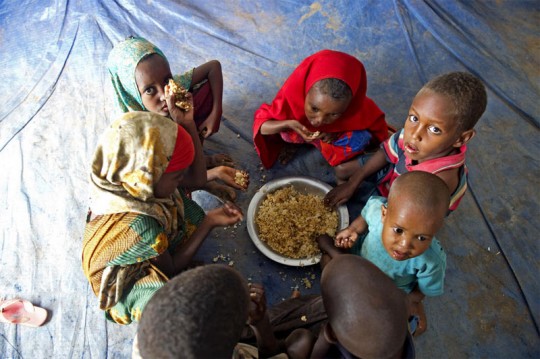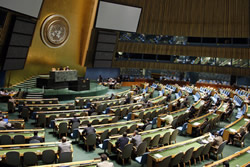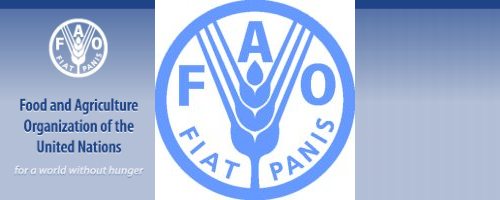UN agencies and US Peace Corps cooperate in fighting hunger
UN agencies and US Peace Corps cooperate in fighting hunger
The United Nations and the United States Peace Corps signed an agreement today to cooperate in combating worldwide hunger by increasing food security in the 76 countries where the more than 8,600 US volunteers currently work.

The agreement, signed by the UN Food and Agriculture Organization (FAO) and UN World Food Programme (WFP) at their Rome headquarters, builds on years of cooperation with the 50-year-old US organization.
“FAO and the Peace Corps have a long history of working together in rural communities throughout the world,” FAO Director-General Jacques Diouf said. “This agreement signals a renewed, enhanced commitment to harnessing the respective strengths and expertise of our three organizations to tackle the root causes of hunger and ensure sustainable food security and economic development.”
Peace Corps Director Aaron S. Williams underscored his organization’s commitment to doing its part to tackle the critical issue of food security at the grassroots level. “Through the important partnerships with FAO and WFP, Peace Corps volunteers will have access to more tools and technical expertise to help improve food security in the communities they serve,” he said.
WFP Executive Director Josette Sheeran highlighted the shared commitment of all three organizations “to give vulnerable individuals in the many nations where we all work a hand up, not just a hand out, to improve their own ability to produce and access food for their families and communities.”
The Peace Corps has worked with FAO and WFP in nearly 40 countries, sharing techniques and practices identified to promote food security through broad-based citizen participation, education, and capacity building. In Swaziland, WFP provided Peace Corps volunteers training on sustainable gardening and organic farming techniques and worked with the volunteers to provide nutrition and hygiene education to children.
In Liberia, four volunteers have been assigned to WFP to provide information to community leaders on proper food storage, handling, and cooking at local schools, while in Namibia, the Peace Corps has worked with FAO in organizing a community garden workshop to grow vegetables.
###
> UN Food and Agriculture Organization (FAO).
The Food and Agriculture Organization of the United Nations (FAO) is an intergovernmental organization and has 191 Member Nations, two associate members and one member organization, the European Union. Achieving food security for all is at the heart of FAO’s efforts – to make sure people have regular access to enough high-quality food to lead active, healthy lives.

FAO’s mandate is to raise levels of nutrition, improve agricultural productivity, better the lives of rural populations and contribute to the growth of the world economy.
The Food and Agriculture Organization of the United Nations (FAO) is working with its Members and the entire international community for achievement of the Millennium Development Goals.
These eight goals – each with specific targets and indicators – are based on the United Nations Millennium Declaration, signed by world leaders in September 2000. They commit the international community to combating poverty, hunger, disease, illiteracy, environmental degradation, and discrimination against women.
![]()
The eight Millennium Development Goals are:
Goal 1: Eradicate extreme poverty and hunger
Goal 2: Achieve universal primary education
Goal 3: Promote gender equality and empower women
Goal 4: Reduce child mortality
Goal 5: Improve maternal health
Goal 6: Combat HIV/AIDS, malaria and other diseases
Goal 7: Ensure environmental sustainability
Goal 8: Develop a Global Partnership for Development
* More information at UN Food and Agriculture Organization (FAO)
###
> United Nations (UN).
 The United Nations was established on 24 October 1945 by 51 countries committed to preserving peace through international cooperation and collective security. Today, nearly every nation in the world belongs to the UN: membership totals 192 countries.
The United Nations was established on 24 October 1945 by 51 countries committed to preserving peace through international cooperation and collective security. Today, nearly every nation in the world belongs to the UN: membership totals 192 countries.
When States become Members of the United Nations, they agree to accept the obligations of the UN Charter, an international treaty that sets out basic principles of international relations. According to the Charter, the UN has four purposes:
- to maintain international peace and security;
- to develop friendly relations among nations;
- to cooperate in solving international problems and in promoting respect for human rights;
- and to be a centre for harmonizing the actions of nations.
###
* The above story is adapted from materials provided by United Nations (UN)
** More information at United Nations (UN)





















